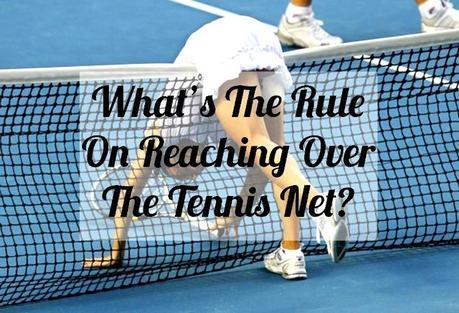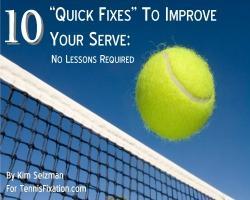Podcast: Play in new window | Download
In this episode of Tennis Quick Tips, I’m going to explain one of the weird rules of tennis that probably gets violated more often than you realize. It’s the rule on reaching over the net. You can listen to this episode by clicking on the gray media player above or by listening in with your favorite podcast app. You can also subscribe in iTunes by clicking on this link: tennisfixation.com/itunes.

SHOW NOTES AND TRANSCRIPT:
If you’re going to put a lot of time, effort and money into playing tennis, you should also put some time and effort into learning the rules of tennis. I’m a huge advocate of knowing the rules because points, games and matches are won and lost based on the proper, and sometimes the improper, application of the rules. We all have had the experience of playing a match where something happens and no one seems to know exactly what the rule is that applies. Or someone seems like they know but you’re not 100% sure that they really do.This happens to me too but not as often as it used to. I’ve really gone out of my way to try and learn the rules of tennis and, when those odd situations come up that I’m not sure about, I pull my trusty rule book out of my tennis bag and make sure we’re all playing correctly.
One of the situations that seems to happen to me a lot so I’m guessing it happens to everyone, is when your opponent reaches across the net.
Now, let me say, I play a lot of doubles and don’t have the most powerful groundstrokes so the net is the best place for me to be. And a lot of ladies I come up against also like to be up at the net. And I say, good for them! Because that’s where you’re supposed to be in doubles.
But a small percentage of ladies I play seem to literally play right on top of the net. And when the ball comes to them, they very often come up with incredible volleys. So it seems like a good idea. The closer, the better, right?
Well, I don’t play 6 inches from the net as these ladies do for two reasons.
1. I need a little room to react and (hopefully) hit a good volley.
2. I don’t want to reach over the net and contact the ball on the wrong side of the net.
Because that’s against the rules!
Rule 24(h) of the USTA’s Official Rules of Tennis says that a player loses the point if “[t]he player hits the ball before it has passed the net . . . .”
A great explanation for what Rule 24(h) means is given on the USTA’s website in their article Reaching Over The Net. I’ll put a link to that article in the show notes for this episode which you can find at tennisfixation.com/quicktips36. The article explains that, while a player can break the plain of the net on a follow through from a shot, the ball must be on that player’s side of the net when the ball was struck. The player cannot touch the net or the opponent’s court with anything he wears or carries or with any part of the body.
To put this in plain English, imagine the net continues straight up towards the sky. It is a straight and flat plane. You can only return a shot by hitting the ball on your side of the plane. So when you are up at the net, you must hit the ball on your side. Your racquet can follow through across this plane but only AFTER you’ve hit the ball.
So why is this a problem? Well, it usually becomes a problem because the person who gets to make the call on whether a player has reached across the net is the player doing the reaching. Paragraph 5 of The Code states that “A player calls all shots landing on, or aimed at, the player’s side of the net.” This means that, while you may think your opponent is reaching, your opponent is the one who makes the call on whether or not he or she is.
Now, if you think this is an odd situation that doesn’t happen too frequently, well, it does. In fact, this exact scenario actually just happened a few weeks ago in a match at the Sony Open in Miami involving Andy Murray and Novak Djokovic. Djokovic supposedly hit a winning shot up at the net and Murray called Djokovic to the net to ask him if he had reached. Djokovic apparently claimed he hadn’t touched the net and didn’t think he’d reached although he didn’t know what the rule was. The chair umpire gave some kind of vague response and let the point stand. Later, Djokovic said he had reached but didn’t know what the rule on that was and thought the point was his since he hadn’t touched the net. Let me just say, I happen to love Novak Djokovic as a tennis player but if I know the rule on this, then he’s absolutely got to know the rule. If he reached across the net to hit the ball, before it had crossed the plane of the net, then he should have lost the point. But this is a good example of exactly the type of situation that can come up in a match that YOU play.
So what do you do when you come up against opponents who are playing right on top of the net, opponents who you THINK are so close to the net that they are be making contact with the ball before it crosses the net? Opponents who you think are violating this rule of tennis?
Here’s how I think you should handle this situation:
- First, watch the player carefully. If someone is constantly playing so close to the net that this might happen, it probably will happen (in my opinion).
- Second, if you think the player has reached across the net, just ask them, “Did you reach across the net to hit that ball?” They will most likely say “no” but now you’ve put the idea in their head and they’ll know you’re watching. When this has happened to me, I usually don’t ask until maybe the third or fourth time that I think they’ve reached.
- Third, if this maybe-they-reached-across-the-net situation keeps happening, keep right on asking about it and bring up the rule: “You do know you can’t reach across the net to hit the ball, right? You lose the point if you do.” For the vast majority of people, these few steps will not only ensure that they don’t reach across the net, but will actually get them to back off the net.
- Finally, if you’re convinced someone is repeatedly reaching across the net but is denying it, let them know you need to bring in a linesman (if you’re at a tournament) or a captain (at a league match) to watch for this. Just be aware, at this point, you’re basically accusing the other player of cheating. Most players will not want it to go this far and, again, should back off.
The bottom line here is to realize that all you can really accomplish here is to make your opponent aware of the rule and to let them know you’re watching. And honestly, there are people who don’t know the rule on this so you may have to educate them. Which is a good reason to have a rule book in your bag.
Now, before we put this reaching over the net thing to rest, just be aware that there is, in fact, one situation where you or your opponent can reach across the net. Again, in that USTA article on Reaching Over the Net that I’m linking to in the show notes, a great explanation is given. The article explains that if the spin of the ball or the wind brings the ball back over the net to the side of the player who hit the shot, the opponent may then reach over the net and play the ball. The opponent cannot touch the net in this situation or the other player’s court. And this is the only situation where a player may reach over the net to play a ball. If the opponent does not play the ball and it bounces on the side of the player who hit the spin shot, that player who hit that shot wins the point.
So are you picturing this? Your opponent hits some kind of nasty spin drop shot that comes over the net, bounces on your side but then spins backward over the net to your opponent’s side of the court. If that happens, you are allowed to reach over and the net and tap the ball into their court, without touching the net or their side of the court. If you fail to tap the ball with your racquet and it lands back on their side, they win the point.
So you’ve got to hit the ball on their side for it to be considered a winning shot.
While this is a weird rule that you probably won’t see too often, that one time you do see it, you’ll know the rule. I actually found a YouTube video of Canada’s Milos Raonic hitting a shot like this in a doubles match a few months ago. I’ll link to it in the show notes and you’ll get an idea of how this type of shot might actually come up in a match. I think you’ll also get an idea of why you probably don’t want to have to ever hit this shot in a match.
RESOURCES AND LINKS FROM THIS EPISODE:
USTA’s article “Reaching Over The Net”
YouTube video of Milos Raonic hitting rare shot from other side of net
SHARE THIS EPISODE:
If you enjoyed this episode, or know someone who might, please feel free to share it with them. You can simply direct people to:
tennisfixation.com/quicktips36
There are also sharing and email buttons at the bottom of this post.
SUBSCRIBE:
I hope you’ll subscribe to the Tennis Quick Tips podcast so you can listen in just as soon as each episode is released. Just click on the appropriate button below:



Or visit the TQT podcast feed URL by clicking HERE.
Thanks for listening and, as always, Happy Tennis!

© Kim Selzman 2014 All Rights Reserved 650 ? 650: true);" class="ois_box_14 container-fluid">If you enjoyed this article . . .There's plenty more!Sign up for FREE Tennis Fixation Weekly Updates and you'll receive my FREE eBook "10 Quick Fixes To Improve Your Serve: No Lessons Required!"



